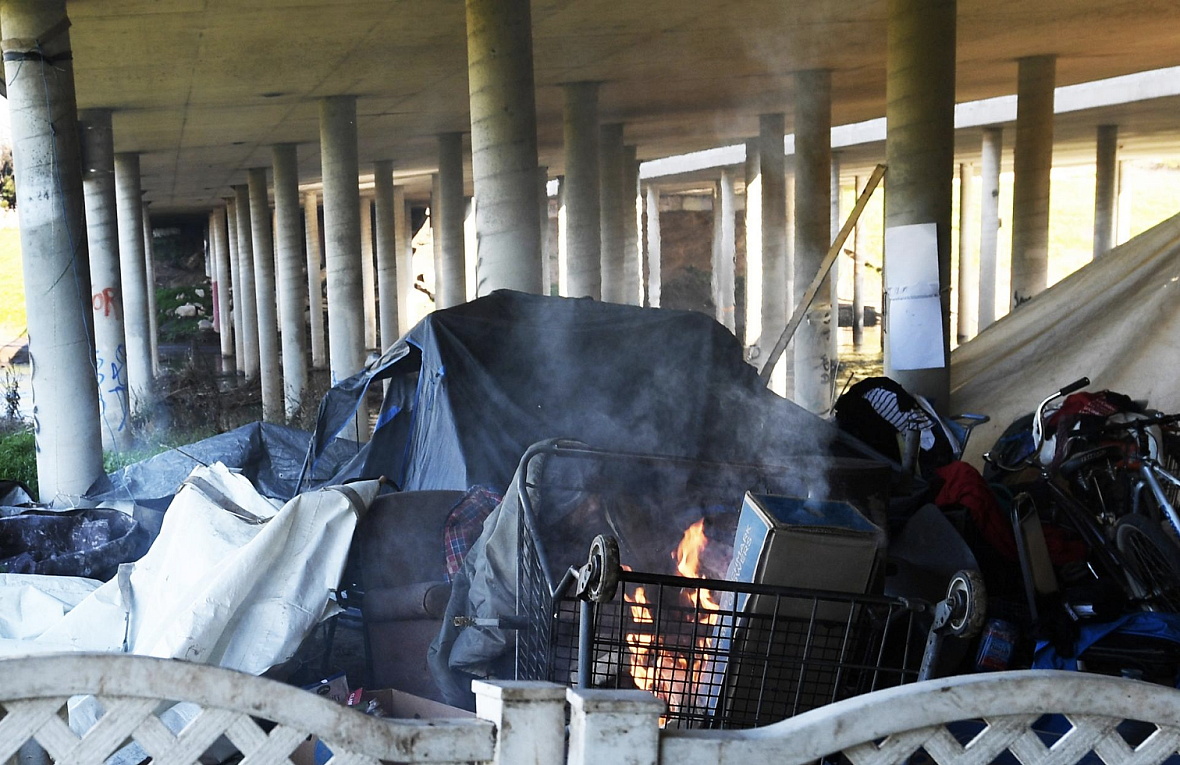Thousands in SJ slipping through health care safety net
This article was produced as a project for the USC Center for Health Journalism’s 2018 Data Fellowship.

Homeless people wrap themselves in tarps as they try to keep warm near a fire at a homeless encampment beneath the El Dorado Street bridge along the Calaveras River. Al House, who has been plagued by a nasty bone marrow infection for three decades and shared his struggles finding health care, lived near the camp.
(Photo Credit: Calixtro Romias/The Record)
STOCKTON — Al House left home at age 10 and has lived on the streets since 2012. When he was in his early 20s, House — now 55 — was shot in the leg, leaving him with a nasty bone marrow infection that’s plagued him for three decades.
When the pain is too much, House somehow manages to get to a hospital emergency room or clinic. For a while, whenever he has had insurance — it’s sporadic, he explained; he’s uninsured right now — he established a medical home with a doctor in Lodi who would clean up the open sore on his shin and prescribe antibiotics.
During a recent clinic visit, House said a physician examined his wound and then left the room.
“They didn’t charge me,” he said. “They just poked around in my leg but never did nothing, and then I was discharged.”
He left no better than when he arrived, returning to a raggedy tent under a bridge that spans the Calaveras River.
House is one of thousands of San Joaquin County residents who slip through the health care safety net — the resources and providers that organize and deliver a significant level of health care and other related services to uninsured, Medicaid (known as Medi-Cal in California) and other vulnerable populations.
He is among those who are uninsured, have no place where they go for treatment until the need is dire and turn to the most expensive form of care, the hospital emergency room.
The majority who rely on the safety net are poor. Many are immigrants — some in the country legally, others illegally — who either don’t understand how to navigate the nation’s complex health care system or are ineligible for public health insurance benefits.
Some have limiting physical or mental disabilities. For others, the barriers may be cultural or language. Lack of transportation to get to appointments often is cited, as is the need to remain home to care for a child or elderly parent.
And in documented underserved areas such as San Joaquin County with nine Health Professional Shortage Areas, according to the Health Resources and Services Administration, simply finding a doctor can be difficult at best.
Health care is expensive, and few people can afford it without insurance. Most working people have access to employer-sponsored private insurance, often sharing some of the cost. People ages 65 and older, and some disabled, have Medicare. A handful of people buy costly individual or family policies, while the Affordable Care Act — embodied through state-run marketplaces such as Covered California — made private insurance far more accessible to tens of thousands of county residents.
For those who still can’t afford private health insurance, there is publicly funded Medi-Cal, the vast first layer of the health care safety net that serves more than 290,000 men, women and children in San Joaquin County or roughly 39 percent of the population, according to the latest figures available from the California Department of Health Care Services.
Of those referred to as “Medi-Cal eligibles:”
• About 74,000 receive benefits today who would not have been eligible before the Affordable Care Act led to the expansion of benefits.
• 127,000 are in the category of a parent or caretaker relative of a child younger than 21 if the child’s parent is deceased or doesn’t live with the child; is incapacitated; or is underemployed or unemployed.
• Just over 10,000 are undocumented, eligible for limited benefits such as emergency medical assistance or prenatal care for pregnant women.
• About 82,000 meet other basic requirements, primarily limits on annual income of no more than 138 percent of the Federal Poverty Level (250 percent for children). For one adult, that is $16,395; for a family of four, it is $33,534; for six, $44,961.
• Other entry points include being 65 and older or 20 and younger; blind; disabled; pregnant; in a skilled nursing or intermediate-care home; on refugee status for a limited time; or screened for breast and/or cervical cancer.
With all those types of coverage, that still leaves some 54,000 county residents uninsured — or slightly more than 7 percent, according to the latest U.S. Census Bureau estimate. Of those, about 33,500 live in Stockton, accounting for 62 percent of the total uninsured in the county.
The good news is that total number has been reduced significantly from a high in 2012 of about 140,000 uninsured residents (20 percent) since the Affordable Care Act took effect.
Slipping Through the Net examines the health care safety net in San Joaquin County. Watch for more stories in coming weeks that take a deeper look at the county’s safety net, the people who do and do not use the services available within the system, and the outreach that is being done to bring more people inside the net.
[This story was originally published by Recordnet.com.]
